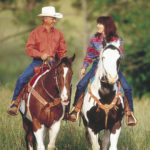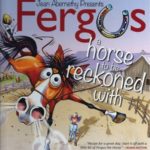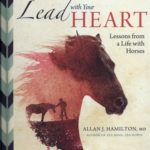A tour by horseback in an unspoiled Mexican village makes for a perfect way to see the jungle and learn about the country’s Mayan history.
February 24, 2007 — After leaving Guatemala (see my first postcard), our ship turned north for Mexico. Costa Maya is along the Caribbean coast of Mexico, about three hours and a planet away from the spring-break haven of Cancun. When the popular cruise ship destination, Cozumel, was destroyed by a hurricane a few years back, the cruise lines got together and invested in a port in Costa Maya. The town there is actually called Majahual, which used to be a sleepy fishing village until the tourism industry came in. Now all the former fisherman drive cabs–apparently it pays a lot better and takes a lot less work.
The port itself consists of a long concrete pier that is probably half a mile walk to shore. There you find the usual shops and restaurants, as well as beaches and a pool owned and plugged by the cruise lines. There also were a number of typical Mexican stands selling the usual pottery, hats, shot glasses and other tchotchkas–also overseen by the cruise ship companies. So it was a bit of a planned experience, and I was looking to get outside the gates and see the countryside.
I’d found out the night before that the riding tour I’d booked through the ship was cancelled due to lack of interest, so I set out into the port area to see what other opportunities presented themselves. At one kiosk I looked into a day tour of the ruins, but they looked similar to those I’d seen in Belize. After weighing my options, I decided to sign up for a riding tour–the same one that had been cancelled by the cruise line. I paid less than half of what I would have on the ship, which was an added bonus. I purchased a bus ticket (all of $3 for a large, air-conditioned tour bus) to the Tequila Bay Resort where the tour was meeting, and headed toward town.
After my trip the previous day in Guatemala, I was a bit leery of a riding tour that met at a resort. However, the guy at the kiosk where I signed up promised me there were all kinds of things to see and do there. I figured I had nothing to lose.
When I arrived at Tequila Bay, I set off to find a guy named Patricio who hooked me up with a key to a locker and suggested I sit under an umbrella until the ranch shuttle arrived. About 20 minutes later, the van pulled up and three of us got on board for the 15-minute ride out to the ranch where the horses were waiting.
At first I wasn’t sure I’d made the right decision: Our guide, John Carlos, was only a few months off the boat from Italy and said he had never ridden before arriving in Costa Maya–though had learned quite a bit riding several times a day, every day for several months. His English and Spanish were pretty good, and he seemed to know the area quite well. He told us about Majahual as he carefully navigated around the deep potholes in the 40-year-old road taking us deeper into the jungle. The two other people in the van were a young couple from New York City that sailed in on another ship. The woman had never ridden before, though she confided it was one of her “life goals” to get on a horse. Her boyfriend said he’d been on a horse maybe once and was looking for a nice, quiet horse and a slow ride.
The horses at the ranch in Costa Maya, Mexico, relax under the shade of the trees.??? 2007 Stacey Nedrow-Wigmore
When we arrived at the ranch, it was quite a different scene from the previous day: The horses looked well fed and seemed content dozing in the shade under the trees. There was a large pasture to the left that had some youngsters kicking up their heels and playing. All good signs, I thought.
The horses were a mix of everything from Draft crosses to Quarter Horse ex-racers from Tijuana. They were clean, feet were trimmed and they seemed happy overall. I was introduced to a flea-bitten gray name Paloma. I hopped up in the saddle, and our guide translated to me that I should be careful with his mouth as Paloma was sensitive to the bit. I found out early on that my horse was used to being a guide horse as he struggled to get to the front of the group. But he was easy and sensitive, and responded to whatever I asked of him, though he was indeed fussy with his mouth and not too happy about the bugs biting his legs. (John Carlos stopped to douse him with fly spray at one point, so he was happier.)
Guide John Carlos points out the flora and fauna of the Mexican jungle.??? 2007 Stacey Nedrow Wigmore
We headed out on a trail cleared through the jungle with John Carlos pointing out different plants such as banana trees, various species of palms and lots of other plants and trees whose names I can’t remember now. We saw hawks and crows overhead and iguanas scampering through the underbrush. John Carlos showed us chickle trees–the same trees that make the sap used to make chewing gum.
We passed by some Mayan ruins (somewhere in the neighborhood of 5,000 years old), which John Carlos said were tombs for the Mayan bigwigs in the community. After awhile we stopped, got off, tied the horses to some trees and checked out the underground rivers in the area and learned about plants used for medicinal purposes. (The people in all three countries we visited still use a lot of the local plants as remedies.) The underground rivers were fascinating. We had a chance to climb down a ladder onto a platform over one of these underground rivers where the earth had crumbled and made a depression under the roots of a tree. John Carlos said some divers had been in there several months ago looking to see how deep the river was and never found bottom. I watched my step as I climbed back out!
Paloma takes a break in the shade halfway through our ride in Costa Maya, Mexico??? 2007 Stacey Nedrow-Wigmore
Once again we swung our legs over our saddles for the remainder of our journey. The horses certainly knew once we were close to the ranch as they booked toward home–just a fast trot, though I’m sure I would have gotten a good canter had I asked. Our small group was parched after almost two hours riding through the jungle and enjoyed cold water while we visited some of the birds–parrots and ring-necked pheasants–that were being rehabilitated in the bird hospital there. Then we headed to a replica of a Mayan home where a woman was cooking fresh corn tortillas over a fire in the hut. We sampled them with salsa, made with herbs grown on the property. The male half of the couple with me on the tour downed a tiny hot pepper growing on a bush in front of the hut and within about five seconds broke out in a sweat and had tears streaming down his face. Apparently the peppers are pretty hot. While his girlfriend later confessed she was initially concerned, we were all laughing so hard that we had tears running down our faces as well. It was good entertainment.
A Mayan descendent makes fresh flour tortillas over a fire in a replica of a Mayan home.??? 2007 Stacey Nedrow-Wigmore
John Carlos loaded us in the van and we headed back to Tequila Bay. He took the scenic route, stopping along the way to pick various types of fruit for us to try, and we also drove past an area where he knew a spider monkey lived. Despite calling to him, the monkey decided he wasn’t getting up from his afternoon nap in the tree. He opened an eye to look at us and then went back to sleep, so we headed on our way. Our guide pointed out the mangroves lining the road and noted the young fish growing up in the shallow orange water where they were less likely to be seen–and eaten. A pair of turtles cooled themselves at the base of a mangrove tree, which told John Carlos that there weren’t any crocs hanging out in the area.
Along the way we also saw examples of typical homes–most made of stucco with thatched roofs. (By the way, the roofs last about 10-15 years, but the locals say that if you cut the leaves three days before the full moon, you get an extra five years out of them. I wish the shingles on the roof of my house had that kind of guarantee!) All of the properties were guarded by barbed wire, apparently because the price of land has gone up exponentially in the last few years, so the owners want to make sure their land is marked while keeping out unwanted people trying to take the land from them at gunpoint.
Once we arrived at Tequila Bay, we said goodbye to John Carlos. In a private moment, he apologized for us not seeing more animals on the trip. Having grown up with horses and other animals for most of my life, it’s a given that wild animals aren’t on call. However, I suppose that many other tourists have been disappointed that the wildlife wasn’t “on the clock” when they were visiting. Maybe those folks should consider going to a zoo instead!
Anyway, if you ever get to Costa Maya, I highly recommend that you take the opportunity to see the area by horseback. It was a fun time, and it was well worth the money. (I would have been happy to go a second time–even on the same trails.) Outside the port, the town comes to life just when the cruise ships are in, so riding is a great way to see the jungle and lot of “behind-the-scenes” stuff.
I hope the area stays pristine, but I doubt it–as do the locals. Get there soon if you want to see one of the last unspoiled places on our planet. And I hear the snorkeling and diving there is fabulous, too–the reef is the second largest in the world next to the one in Australia.
Well, I guess it’s back to reality tomorrow. (Big sigh.) We’ll be back in US territory when I wake up tomorrow morning. Until then, I’ll be making the most of my time left by sipping an umbrella drink on the aft deck after my scheduled facial. Perhaps I could get used to this relaxation thing…!
Stacey Nedrow-Wigmore is the managing editor of Practical Horseman magazine, a life-long rider and competitor, and loves to travel.







